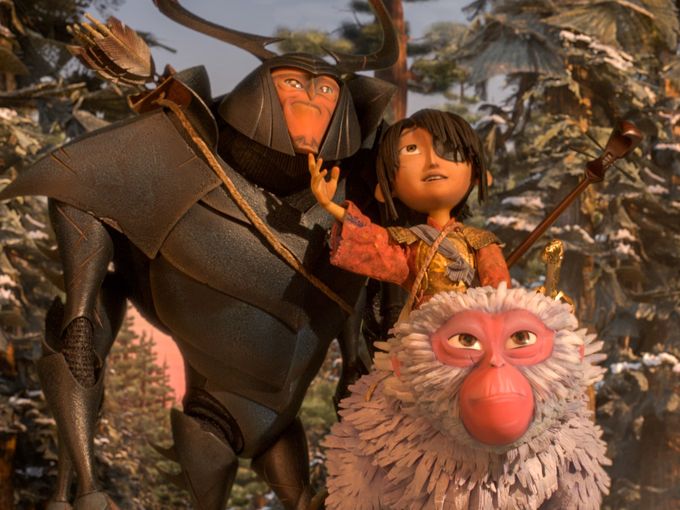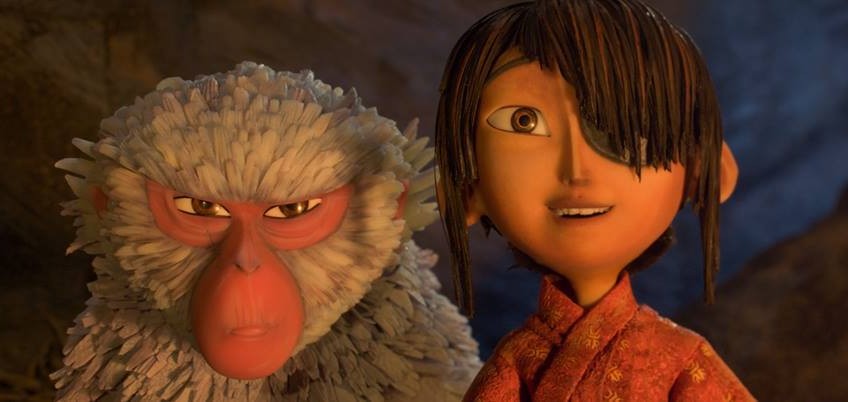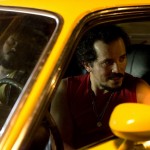Joyce Glasser reviews Kubo and the Two Strings (September 9, 2016)
It is ironic that Kubo and the Two Strings, a dazzling, state-of-the-art combination of stop-motion, hand-drawn and CGI animation from Laika (The Boxtrolls, Paranorman, Coraline), is all about the magic of non-technological story-telling. Kubo (Art Parkinson), the one-eyed son of the forbidden union between the enchantress Sariatu (Charlize Theron), and samurai warrior, Hanzo, ekes out a living by entertaining isolated villagers with his invalid mother’s stories. To their delight (and ours) Kubo illustrates them with origami characters called forth by his one-string samisen. Form and content merge in this gorgeous mythical epic in which Kubo tells the villagers and modern day audiences: ‘If you must blink, do it now’.
In a spectacular opening scene we see a woman (Sariatu) escaping some unknown force on a small boat battling dark, high waves. Battered, but alive, she is washed up on a remote shore next to a bundle containing a baby. We meet mother and son years when Kubo, a young boy, is hiding out with his mother in a cave on the top of a mountain. Kubo is now caring for Sariatu who is losing her memory and her strength – zapped by the changing moon: the same moon that governs the tides.
As Kubo feeds her, she feeds him stories that he repeats to the illiterate villagers, illustrated with marvellous origami characters that he calls forth by strumming on his samisen. If he could stay in the town later he might make more money, but his mother warns him never to be out after dark. She fears that his twin aunts (Rooney Mara) and his grandfather, the Moon King (Ralph Fiennes) will return to claim his other eye and condemn him to darkness. This family feud is not over money, but like the Nordic myths that spawned the Ring Cycle, about humanity and love vs. immortality.
One day, however, after a performance, Kubo is caught out after dark. His mother cannot save him as he is hurled out of his boyhood into a dangerous world. Kubo’s perilous search for his father’s legacy leads him to his own.
 Sariatu has, however, been thinking ahead and provides her son with an efficient, fierce, but caring surrogate mother, in the shape of Monkey (Theron again) and a surrogate father – a beetle (Matthew McConaughey) who has been transformed into a Samurai. Kubo’s task – and the only way to survive – is to find three items left behind by the father he never knew: The Armour Impenetrable, The Sword Unbreakable and the Helmet Invulnerable. These items seem more of an excuse to introduce an otherwise episodic string of random adventures than items that ultimately save Kubo, but they are fun for children and do play a role.
Sariatu has, however, been thinking ahead and provides her son with an efficient, fierce, but caring surrogate mother, in the shape of Monkey (Theron again) and a surrogate father – a beetle (Matthew McConaughey) who has been transformed into a Samurai. Kubo’s task – and the only way to survive – is to find three items left behind by the father he never knew: The Armour Impenetrable, The Sword Unbreakable and the Helmet Invulnerable. These items seem more of an excuse to introduce an otherwise episodic string of random adventures than items that ultimately save Kubo, but they are fun for children and do play a role.
This quest (and viewers will be reminded of both the Wizard of Oz and the Christian and pagan myths of the holy grail) means that Kubo, Monkey and Beetle will travel together on a kind of perilous yellow brick road, some of which is very cold (the blizzards of the Far Lands); hellish (the Hall of Bones); watery (the underwater Garden of Eyes) dangerous (The Bamboo Forest) and, a tad superfluous.
Monkey and Beetle provide some welcome comic relief along the way, and, like everything in this clever, if somewhat overwritten story, it dawns on you that the relationship between Monkey and Beetle more than mirrors the relationship between Kubo’s real parents. At first, the serious, obsessively protective and instinctively suspicious Monkey mistrusts Beetle, but their initial sparring masks a growing attraction and mutual respect when the bungling Beetle proves to be courageous and adept as well as dreamily gallant.
Perhaps nowadays you need famous American/British names to get a movie funded, but Brenda Vaccaro’s villager and Rooney Mara’s evil sisters could easily have been cast for Japanese voices. There is something jarringly American about Theron’s seductive voice, one that is more motherly and soothing than regal and mystical.
The painstakingly slow, expensive and meticulous process of puppet-based, stop-frame animation is easy for today’s audiences to take for granted, and apparently Laika CEO, Producer and first time Director Travis Knight felt that he had to add 3D to compete with the larger animation studios, such as Disney, Pixar and Dreamworks. The 3D is not distracting, but not necessary.
Knight, a Japanophile, seamlessly weaves Japanese cultural imagery into the film beginning (and ending) with Katsushika Hokusai’s famous wave. Hanzo’s likeness is Knight’s homage of Toshiro Mifune (star of The Seven Samurai). Kubo’s eye patch is homage to Date Masumané, a legendary warrior in feudal Japan and to the master swordsman of the Tokugowa Shoguns, Yagyu Jubei Mitsuyoshi. Kubo’s helmet markings are based on Jomon, or code markings found on Neolithic pottery in Japan. For all the acknowledged mythical references, however, it is the Egyptian story of Osiris, Seth and Isis — that begins when the god of magic, Thoth, zaps the strength of the Moon-god, Khonsu in a wager — that seems applicable.
After the dark, evil brother Seth slays Osiris, his wife, Isis becomes very protective of their son, Horus. But Horus must avenge his father. In a fierce battle, Seth cuts out one of Horus’s eyes. If the Egyptian myth is about militant revenge, Kubo and the Two Strings ends (in a rather hurried, expository, and sentimental manner) with Kubo opting for the power of forgiveness and reconciliation.
While enthralled young audiences will be watching the illustrated end credits, parents and grandparents will be consumed by Regina Spektor’s moving cover of George Harrison’s ‘While My Guitar Gently Weeps’, a fitting plea for harmony and love.




